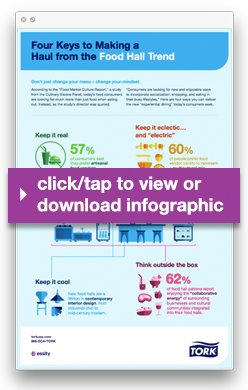The millennial jury has delivered its verdict on Food Courts: guilty on multiple counts, starting with Boredom in the First Degree. The new excitement is in Food Halls, those market-style, eating-shopping-socializing centers where you’re more likely to see customers with man buns than national chains selling cinnamon buns.
So how can established businesses pivot from that old foodservice mainstay to what might better be called the new “food experience” innovations? Recent research gives us a few good clues, and they’re not just about your menu.
Don’t just change your menu – change your mindset
 According to the “Food Market Culture Report,” a study from the Culinary Visions Panel, today’s food consumers are looking for much more than just food when eating out. Instead, as the study’s director was quoted, “Consumers are looking for new and enjoyable ways to incorporate socialization, shopping, and eating in their busy lifestyles.” Here are four ways you can deliver the new “experiential dining” today’s consumers seek.
According to the “Food Market Culture Report,” a study from the Culinary Visions Panel, today’s food consumers are looking for much more than just food when eating out. Instead, as the study’s director was quoted, “Consumers are looking for new and enjoyable ways to incorporate socialization, shopping, and eating in their busy lifestyles.” Here are four ways you can deliver the new “experiential dining” today’s consumers seek.
Keep it real
Authenticity isn’t just a buzzword here, it’s the heart of what the food hall trend is all about. As “The Food Halls Report” from Cushman and Wakefield notes, this is a growing movement, versus a passing fad, driven by a “new consumer who looks for authenticity, source-ability (farm-to-fork), quality and uniqueness in food offerings, as well as quality in the surroundings in which the food is served.” And the Culinary Visions research reinforces that finding, indicating that there’s a real “art” to creating a compelling food hall… as in the need to include artisanal food vendors, which fifty-seven percent of consumers said they prefer.
Keep it eclectic… and “electric”
Perhaps more than anything, the research points to a consumer craving for variety in food experiences. Over half of the people surveyed said they enjoy food halls because there’s “a little something for everyone,” and sixty percent specified that they prefer their variety to represent a multicultural mix. In other words, instead of pizza, burgers and fries, you may see this new wave of consumers sit down to a dinner of ramen, fish tacos and gelato.
They’re looking for variety and excitement when they get up from the table, too. These experientially-oriented customers want to browse specialty retail like handcrafted jewelry, pick up some meat from a local butcher to take home, hear music, or have a chance to chat with the artisans who grow, craft and cook their meals. In short, food halls are as much about satisfying the modern imagination as it is about serving food.
Keep it cool
While the idea of food courts may conjure up bad plastic seating, screaming toddlers and loitering (or littering) teenagers, a food hall needs to be a bastion of cool, with a creative, contemporary look and feel. And while most food courts reflected a match-the-mall aesthetic, the new food halls are a lesson in contemporary interior design, from industrial chic to mid-century modern. Those who succeed in this arena — whether developers or individual vendors — are likely to be the ones that continue to push the design envelope.
Think outside the box (even if that’s how the fancy new food is served)
Possibly the biggest challenge facing the foodservice industry as it contemplates how to make the most of this new trend is to remember that it’s not just about the food. And it’s certainly not about “how it’s always been done.” All participants in the mix, from developers to food vendors to the surrounding business and cultural communities, will do well to creatively collaborate — in fact, it’s almost a consumer prerequisite, as sixty-two percent of food hall patrons report enjoying the “collaborative energy” they feel.
As food courts continue to decline, will you be ready to make a haul from food halls?
(For a quick look at what’s going on in the top twenty such offerings in America,
see the back pages of “The Food Halls Report”).
Sources:
“Food Market Culture Report” from Culinary Visions
“The Food Hall Report” from Cushman & Wakefield
